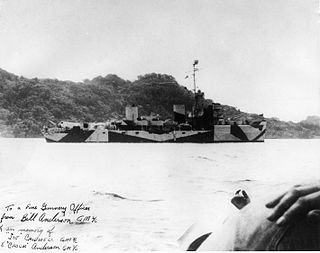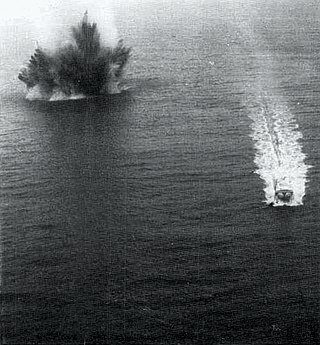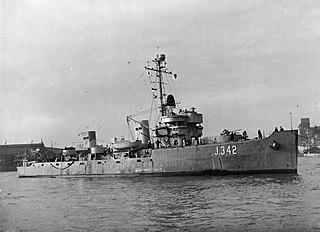Related Research Articles

A minesweeper is a small warship designed to remove or detonate naval mines. Using various mechanisms intended to counter the threat posed by naval mines, minesweepers keep waterways clear for safe shipping.

The Admirable class was one of the largest and most successful classes of minesweepers ordered by the United States Navy during World War II. Typically, minesweepers detected and removed naval mines before the rest of the fleet arrived, thereby ensuring safe passage for the larger ships. They were also charged with anti-submarine warfare (ASW) duties with rear-mounted depth charge racks and a forward-firing Hedgehog antisubmarine mortar. Their job was essential to the safety and success of U.S. naval operations during World War II and the Korean War. These minesweepers were also employed as patrol vessel and convoy escorts. The only remaining ship of this class is located at Freedom Park, Omaha, NE.

USS Hogan (DD-178/DMS-6) was a Wickes-class destroyer in the United States Navy during World War II.

Operation Albion was a World War I German air, land and naval operation against the Russian forces in October 1917 to occupy the West Estonian Archipelago. The campaign aimed to occupy the Baltic islands of Saaremaa(Ösel), Hiiumaa (Dagö) and Muhu (Moon). The three islands were part of the Russian Empire and strategically dominated the central and northern Baltic Sea. The land campaign opened with German landings at the Tagalaht (Tagga) bay on the island of Saaremaa (Ösel), on 12 October, after extensive naval operations to clear mines and subdue coastal artillery batteries. German forces secured the island by 16 October and the Russian army evacuated Muhu (Moon) on 20 October.

A mine countermeasures vessel or MCMV is a type of naval ship designed for the location of and destruction of naval mines which combines the role of a minesweeper and minehunter in one hull. The term MCMV is also applied collectively to minehunters and minesweepers.
USS Pigeon (AM-374) was an Auk-class minesweeper acquired by the United States Navy for the dangerous task of removing mines from minefields laid in the water to prevent ships from passing.
Operation 34A was a highly classified United States program of covert actions against the Democratic Republic of Vietnam, consisting of agent team insertions, aerial reconnaissance missions and naval sabotage operations.

USS Ruddy (AM-380) was an Auk-class minesweeper acquired by the U.S. Navy for the dangerous task of removing mines from minefields laid in the water to prevent ships from passing. She was the only U.S. Navy ship named for the North American ruddy duck.

USS Velocity (AM-128) was an Auk-class minesweeper acquired by the United States Navy for the dangerous task of removing mines from minefields laid in the water to prevent ships from passing. She was the second warship to bear the name.
USS Spear (AM-322) was an Auk-class minesweeper acquired by the United States Navy for the dangerous task of removing mines from minefields laid in the water to prevent ships from passing.

USS Lapwing was a YMS-1-class minesweeper of the YMS-135 subclass built for the United States Navy during World War II. She was named after the lapwing.

USS Grackle was a YMS-1-class minesweeper of the YMS-135 subclass built for the United States Navy during World War II.
USS Staunch (AM-307) was a steel-hulled Admirable-class minesweeper built for the U.S. Navy during World War II. Her crew was quickly trained in the art of minesweeping and then sent to the Pacific Ocean to clear dangerous mine fields so that Allied troops could land on Japanese-held beaches. Because of her courageous work under fire, she was awarded four battle stars.

USS Scrimmage (AM-297) was an Admirable-class minesweeper built for the United States Navy during World War II. She was built to clear minefields in offshore waters. She served in the Pacific Ocean and, because of her valiant efforts in combat, her crew returned home with six battle stars.
Coastal minesweeper is a term used by the United States Navy to indicate a minesweeper intended for coastal use as opposed to participating in fleet operations at sea.

USS Auk (AM-38) was a Lapwing-class minesweeper acquired by the United States Navy after World War I to remove mines that had been placed during the war.

Operation End Sweep was a United States Navy and United States Marine Corps operation to remove naval mines from Haiphong harbor and other coastal and inland waterways in North Vietnam between February and July 1973. The operation fulfilled an American obligation under the Paris Peace Accord of January 1973, which ended direct American participation in the Vietnam War. It also was the first operational deployment of a U.S. Navy air mine countermeasures capability.

Pasewalk (GS05) was a Kondor I-class minesweeper built in East Germany. After the Volksmarine was disbanded just before the reunification of Germany, she was sold to Malta in 1992 and renamed P31 and was used as a patrol boat. After being decommissioned, she was scuttled as a dive site in 2009 off Comino.

Project Hula was a program during World War II in which the United States transferred naval vessels to the Soviet Union in anticipation of the Soviets eventually joining the war against Japan, specifically in preparation for planned Soviet invasions of southern Sakhalin and the Kuril islands. Based at Cold Bay in the Territory of Alaska, the project was active during the spring and summer of 1945. It was the largest and most ambitious transfer program of World War II.

HMS Gazelle was a Catherine-class minesweeper of the Royal Navy.
References
![]() This article incorporates text from the public domain Dictionary of American Naval Fighting Ships .
This article incorporates text from the public domain Dictionary of American Naval Fighting Ships .